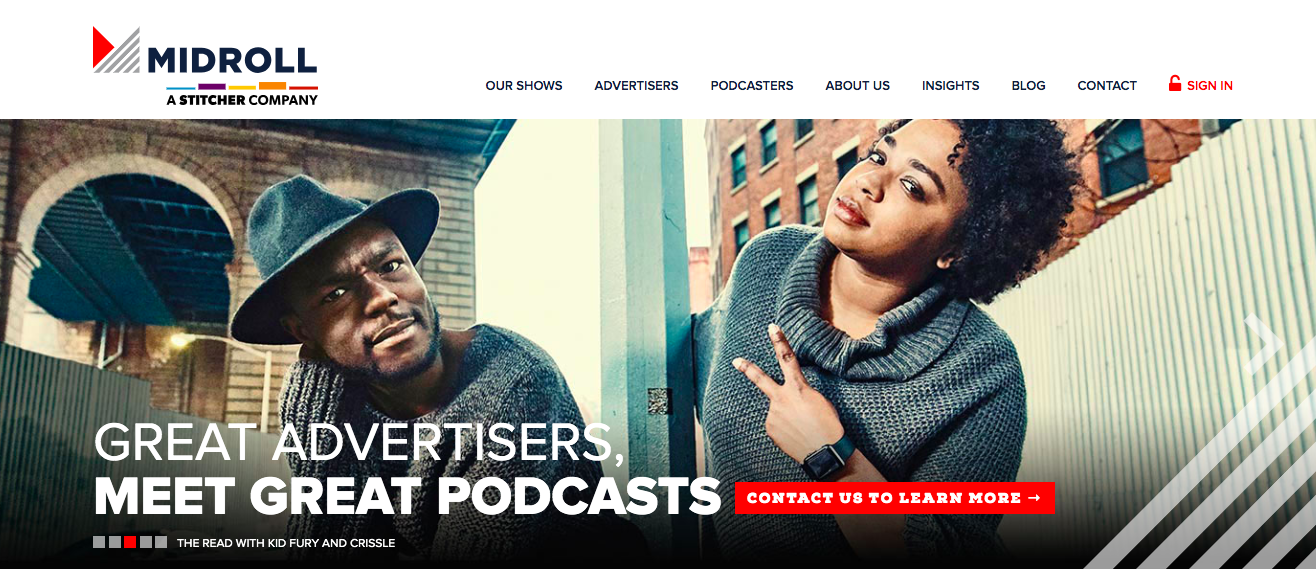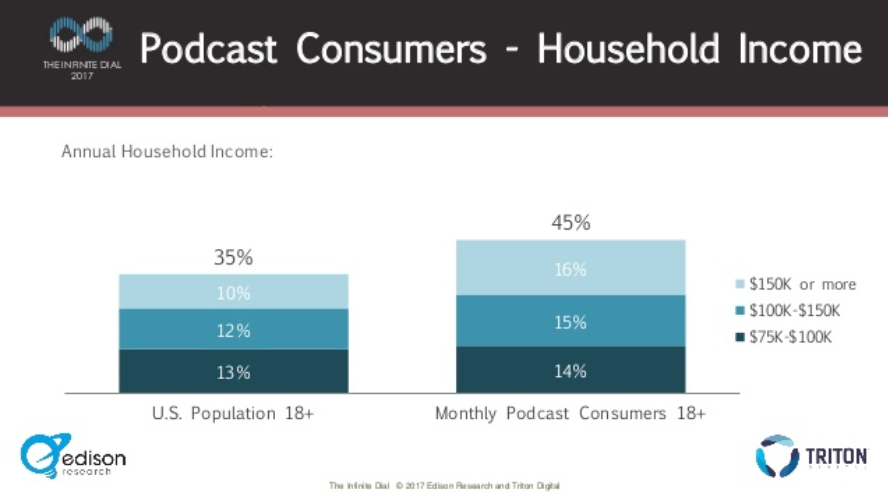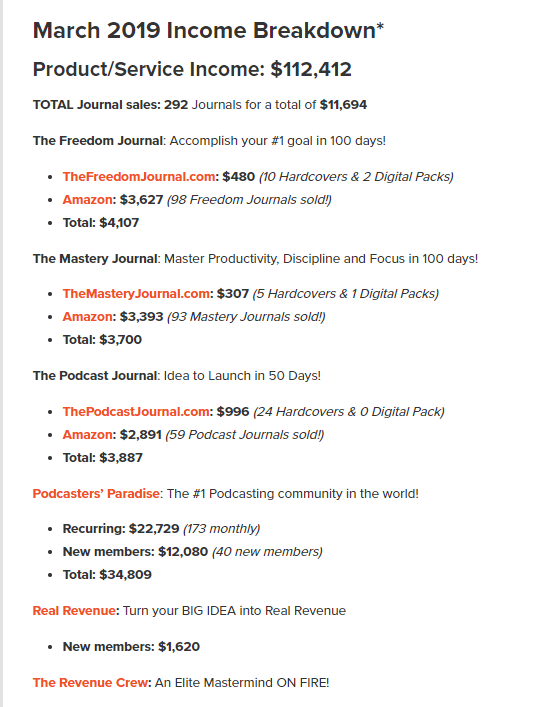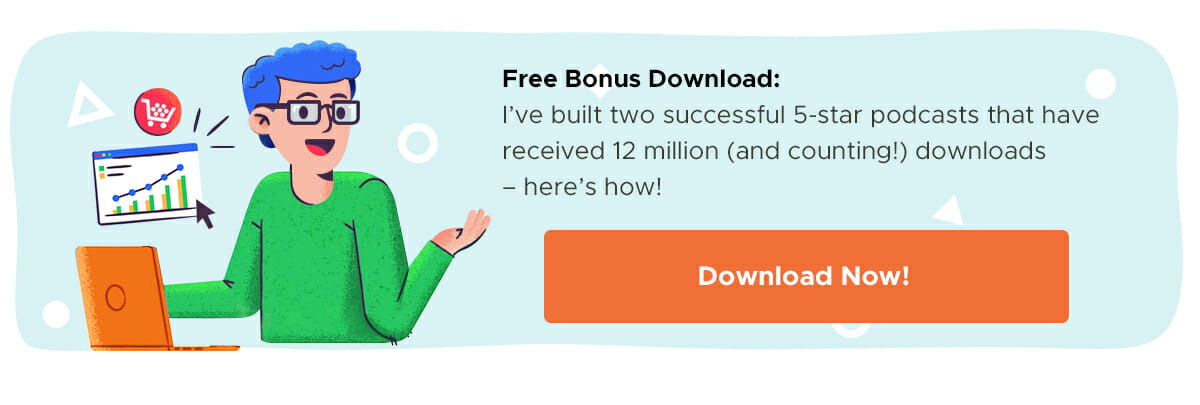Podcasts can be a great way to connect with an audience, grow your brand and develop your perceived authority within a niche. But they can also make you money – as long as you know how to monetize your show.
If you’re new to podcasting, check out these seven strategies that will get you generating revenue from your podcast. Even if you don’t yet have a large enough audience to make these strategies work, add them to your arsenal as your show grows.
And if you’re already podcasting with a good-sized audience, jump in!
Strategy #1: Podcast Advertising
Ok, so maybe this isn’t exactly “creative,” but it definitely deserves a mention at the top of this list. If you want to make money from your podcast, try taking on advertisers who will pay money to pitch their products to your audience.
If you’ve ever listened to The Tim Ferriss Show, you know that he usually has a pre-roll ad section at the beginning of the podcast, and a post-roll ad that comes up after the show (last I know, he wasn’t doing a mid-roll ad section, but he could if he wanted to add more revenue).
So let’s say the average CPM, or “cost per thousand impressions” right now is around $30. Tim is probably able to command closer to $50 CPM at least, given how popular his show is. Although I don’t know for sure how many downloads he gets these days, Tim published the following chart on his blog at the end of 2016 to celebrate crossing the 100 million download threshold:

If we average Tim’s download numbers for September, October and November, we get 5,303,851 downloads per month. And since Tim publishes, on average, one podcast per week, we can divide that number by four and assume that each episode he produces receives at least 1,325,962 downloads.
Now, let’s do the math… If Tim has four ad blocks, and he earns an average of $50 CPM for each of them, that’s:
1,325.96 X $50 X 4 = $265,192.40 per episode
If he does four episodes in a month, Tim earns $1,060,769.60 per month at these rates or $12,729,235.20 per year – just by including ads on his show.
To be clear, I’m making a lot of assumptions here. I don’t know for sure that Tim includes four ad blocks on every episode or that he publishes at least four episodes per month. I don’t know if he commands $50 CPM ad rates and I’m basing my calculations above off his 2016 download numbers. Since he recently crossed 300 million in lifetime downloads, there’s every reason to believe he has even more listens these days, which means these numbers could be far higher.
So while I don’t claim that these numbers are completely accurate, I hope they show you how lucrative podcast advertising can be.
That said, you’re not Tim Ferriss. You probably don’t have 300 million downloads, let alone the kind of active, engaged audience that allows Tim to earn these high CPM rates.
That doesn’t mean that there aren’t advertisers who will want to place their ads on your show, but there are several steps you’ll want to take in order to make your podcast as appealing as possible for future advertisers.
Dive Deeper:
How Do I Get Advertisers on My Podcast?
A) Increase Your Podcast Subscriber Base
There are plenty of different ways to advertise your podcast, from appearing as a guest on other podcasts, to promoting it by using traditional digital marketing tactics like SEO and email marketing.
And since elements like subscribers and reviews play into how podcast directories surface your podcast, ask your listeners in each episode to rate, review and subscribe.
Engaged audience members will want to ensure that you keep your podcast on air. Explain the importance of ratings and reviews, while keeping within the tone of your podcast. We’ve heard comedy podcasts self-deprecatingly call their pleas for ratings and reviews ‘The desperation segment of the show.” If that’s not your vibe, explain that you want to keep your valuable content coming and ratings, reviews and subscribes help do that.
Test a few different tactics and see what works best for you. Then, scale your efforts as much as possible. The larger your audience, the more that advertisers will pay you to access it.
B) Know Who Your Subscribers Are
Podcast audience size isn’t everything. Before a company decides to advertise on your show, they’ll want to see that you’re reaching the right people for your brand – and that those subscribers are actually engaged with you.
One of the best ways to do this is to have a very clear understanding of who your audience is and what they want to hear from you. You’ll notice that on our Marketing School podcast, Neil and I keep a pretty narrow focus on marketing tactics and insights.
We do that because we know that’s why our audience listens to us. If we were to break out all of a sudden and start talking about sports or nutrition, we’d risk alienating an audience that we know relies on us for marketing messages.
Same with suddenly making our podcast 30 minutes or an hour (instead of 10 minutes), or airing it once a week (instead of once a day). People rely on us for quick marketing snippets every single day and we provide consistent subject matter and format.
C) Connect with a Podcast Advertising Agency
Once you’ve built up your subscriber base and identified a common theme for your podcast, reach out to podcast advertising agencies like AdvertiseCast and Midroll:

Although these networks may take a chunk out of the CPM paid to you from advertisers, their ability to connect you with a larger audience of advertisers and to seamlessly facilitate the ad placement process can be worth it. (More thoughts on this here.)
Strategy #2: Host an IRL Podcast Event
I have nothing against putting advertising on your podcast, but it’s not something Neil and I have chosen to do. We said we weren’t going to advertise, and we’ve stuck with that.
Instead, we’re starting to host events, which we can advertise to our podcast listeners, such as our upcoming event in L.A. in June. We aren’t charging for this event, but that doesn’t mean you couldn’t.
Suppose you decided to host a day-long seminar, and you price your tickets at $299 each. If you have even a small audience of 10,000 regular podcast listeners, and you were able to get just 1% of them to come to your event, that’s almost $30,000 in revenue – all from your podcast!
Strategy #3: Host VIP Experiences for Your Subscribers
Even if you run a live event that’s advertised to your podcast listeners and don’t charge for it, you can still make money.
For our Marketing School DTLA event, for example, we aren’t charging for tickets, but we are going to host a private dinner for 20-25 people, and we expect to sell out those seats at $2,000 each. So even without ticket revenue, we’ll gross nearly $50,000 on the dinner alone.
We’ll also make money by reaching out to premium-tier sponsors that make sense for our audience. That’ll help us cover most of the costs of running the event, so that anything extra – along with the revenue from the dinner – will be our profit.
Your “VIP Experience” might not be a dinner. It might not even be a live event. It might just be the opportunity to work with you one-on-one, extended to a limited number of podcast listeners. Figure out what your audience wants from you, and then look into different options for serving it up to them in the form of an exclusive VIP experience.
One of the great things about podcasts is that they reach a high-income, highly educated demographic. According to Edison Research’s report, The Podcast Consumer 2017, “Compared to America as a whole, monthly podcast listeners are 29 percent more likely to have a [household income] of $75,000 or more.”
 Don’t assume that podcast listeners won’t be able to afford your highest-price offers. Of all the advertising channels at your disposal, hosting a podcast may actually be one of the best ways to reach high earners.
Don’t assume that podcast listeners won’t be able to afford your highest-price offers. Of all the advertising channels at your disposal, hosting a podcast may actually be one of the best ways to reach high earners.
Learn More:
Strategy #4: Charge a Subscription Fee
Yes, most podcasts are available for free. But what if yours wasn’t? What if, instead of giving your information away as-is, you charged even $5 or $8 a month for it?
Charging for podcast subscriptions isn’t huge in the U.S. yet, but it’s actually pretty common in Asia.
According to TechCrunch’s Eric Peckham, the Chinese podcast market dwarfs the U.S. market because subscription fees are the norm: “To my understanding, the definition of podcast here may be broader than the scope in the U.S. — by including audio courses — but the Chinese government estimated the market for paid podcasts alone as $7.3 billion in 2017.”
Compared to the $659 million in podcast ad revenue that the Interactive Advertising Bureau (IAB) and PwC estimate the U.S. market could see in 2020, the potential for subscription fees becomes obvious:

Again, let’s crunch some numbers for fun.
Let’s say that our Marketing School podcast gets 100,000 listens each month. We aren’t planning to do this, but if we added premium content and started charging $5 per month for access, that’s $500,000 in new monthly revenue — or $6 million per year.
Where the calculations get interesting is in comparing them to putting ad blocks on the podcast. Say we took those same 100,000 monthly listeners and started running two ad blocks on each of our daily shows at $35 CPM (since we aren’t as popular as The Tim Ferriss Show):
30 shows X $35 CPM @ 100 X 2 = $210,000 per month
Not only would we earn less money through ads than we would by pursuing a paid model, but we’re adding the complexity of having to work with advertisers, in addition to potentially disrupting listeners’ experience with intrusive ads.
That isn’t to say that one of these strategies is better than the others (and it’s probably unrealistic to assume that all 100,000 listeners would opt in to paying a subscription fee). The goal here is just to get you thinking about the possibilities. Crunch the numbers for yourself. Explore different options — like Stitcher Premium or Patreon — in order to find the right monetization strategy for your business and your audience.
Strategy #5: Offer Info Products to Your Podcast Audience
Your podcast audience is an engaged (and captive) audience. These audience members are already eating up your audio-based content, so why not send them to landing pages where you sell them e-books, courses and other info products?
John Lee Dumas of the Entrepreneurs on Fire podcast is a great example of this. And because John publishes monthly income reports, we can see exactly how much he makes by promoting his own information products to his audience.
In March 2019, for example, we can see that John cleared more than $100,000 in product and service revenue:

There’s a big caveat here, which is: in order to sell your audience info products, you have to build info products. That takes time and other resources that need to be considered when you’re estimating potential income.
However, if you have an engaged audience and you know what they’re interested in, packaging the knowledge you already have into info products and selling them to your listeners can be a great way to monetize your podcast.
Strategy #6: Promote Affiliate Products on Your Podcast
You can’t see it in the graphic above, but in addition to the more than $112,000 John made selling his own products and services in March 2019, he also earned nearly $43,000 in affiliate revenue.
Selling affiliate products means that, rather than creating your own info products, you promote resources created by others in exchange for a commission on any sales that result from your promotion.
Generally, you’re given a special link to share with your audience, and whenever someone buys through it, you’re given a set commission, according to your affiliate agreement.
Affiliate products can be a great way to monetize your podcast without putting all the effort into building your own products.
But Joe Rogan is another great example of the way these relationships can grow beyond individual promotions. After promoting nutritional supplements from Onnit on his podcast, The Joe Rogan Experience, Joe negotiated an equity ownership stake in the company from founder Aubrey Marcus.
Learn More: Why Affiliate Marketing Is a Great Option for Startups
Strategy #7: Sell Physical Products on Your Podcast
One last monetization strategy that’s inspired by John Lee Dumas’s example is expanding from digital products to physical products – in his case, his print edition Freedom Journal. You’ll see a lot of podcast hosts selling journals because audiences love them, and they’re a kind of product that produces a lot of engagement among users.
That doesn’t mean you have to do a journal. If you have a print book, you could sell that on your podcast. You could sell branded clothing or other gear if you have a recognizable podcast brand or logo.
Yes, it’s going to take more work to produce these items, and you’re going to have to think about how much inventory you can hold at any given time. But as you can see from John’s example, moving into physical products adds another revenue stream that further increases your podcast’s value.
